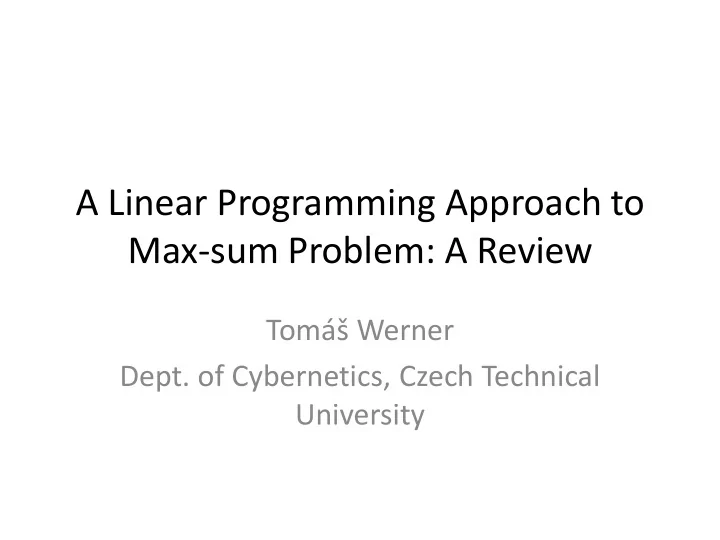

A Linear Programming Approach to Max-sum Problem: A Review Tomáš Werner Dept. of Cybernetics, Czech Technical University
Max-Sum Problem e.g. the MAP problem on MRFs
Formulation of the Problem G = (T, E) T is a set of objects, x t X is a labeling on t T E 2 G’ = (T × X,E X ) g t = (t, x) g tt’ = {(t, x), (t’, x’}
Commutative Semirings
Rings (S, , ) (Z, , )
Semirings
Semirings CSP Denote a problem by (G,X, ) – Graph, Domain, Constraints g Let t (x), tt’ (x,x ’) = {0,1} say if an assignment is allowed or g g forbidden
Arc consistency in CSP The kernel can be obtained by iteratively applying the following relations until no more 0 assignments are made (arc consistency algorithm)
Semirings Max-sum Denote a problem by (G,X,g) – Graph, Assignments, Weights
Equivalent Transformations Also known as ERs (Wainwright) A problem is called equivalent if (G,X,g) and (G,X,g ’) produce the same problem, denoted as g~g ’ The simplest such transformation adds a number φ tt’ (x) to g t (x) while removing from g tt’ (x,x ’) This formulation corresponds to potentials or messages from message passing
Schlesinger’s Upper Bound
Triviality (t,x) is a maximal node if g t (x) = u t {(t,x), ( t’,x’)} is a maximal edge if g tt’ (x,x ’) = u tt’ t (x) = [[g t (x) = u t ]] tt’ (x) = [[g tt’ (x,x ’) = u tt’ ]] g g A max-sum problem is trivial if a labeling can be formed of a subset of its maximal nodes and edges
Triviality Testing for triviality of a max-sum problem is correspondent to solving the CSP generated by its maximal nodes and edges A CSP is a tight solution to all max-sum problems it can be equivalently transformed into
Equivalent Transformations (CSPs)
Linear Programming Relaxation This gives the polytope which has a set of optimal vertices given by
Duality of the Relaxations
More theorems fall out Finding the kernel does not guarantee finding a solution for the minimal upper bound Obvious by approach from CSPs For problems of boolean variables |X| = 2 finding the kernel is necessary and sufficient for finding the upper bound
(Super) Submodularity Known that the (super) submodularity property produces max- sum problems with tractable solutions by conversion to max- flow/min-cut problems Has been suggested that supermodularity is the discrete counterpart of convexity. Lots of work shows that the LP relaxation for a supermodular max-sum problem is tight Supermodular max-sum problems will always form a lattice CSP with a tractable solution
An application (not just theory!)
Recommend
More recommend